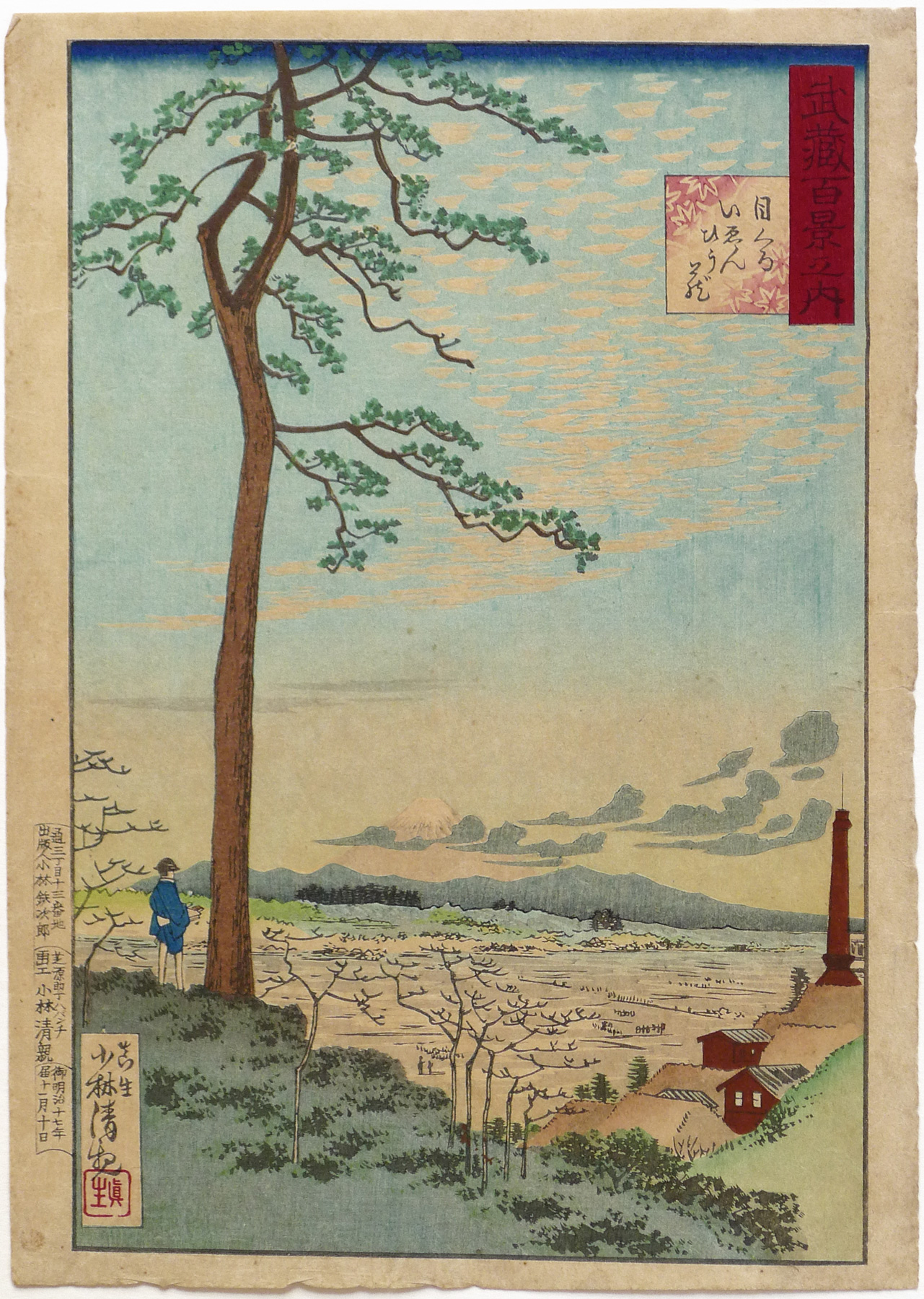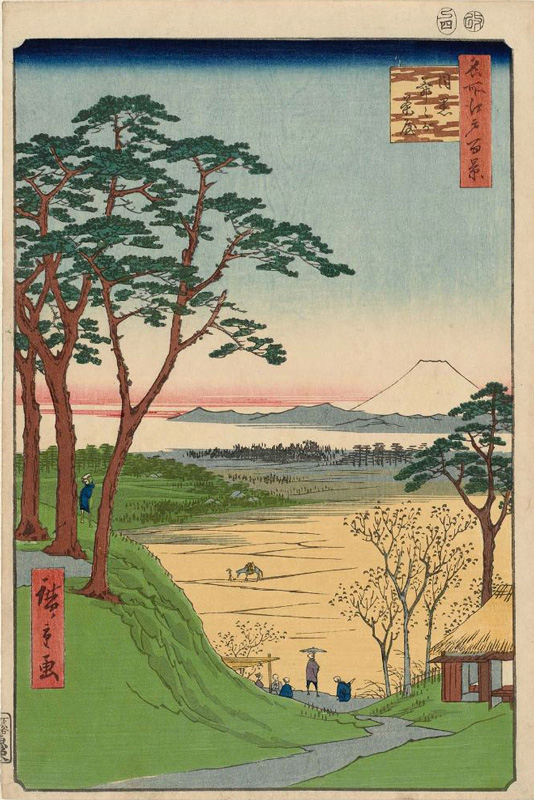About This Print
A lone figure stands on a hillock overlooking the Meguro Gunpowder Factory. Mt. Fuji is seen through the smoke generated by the factory. Meguro Arsenal is one of thirty-four prints that make up the never completed series One Hundred Views of Musashi. (Musashi being the name of the province that included Edo/Tokyo.) The series was inspired by Utagawa Hiroshige's (1797–1858) series One Hundred Views of Edo, published between 1856 and 1859.About The Series One Hundred Views of Musashi
Source: Beyond the Great Wave: The Japanese Landscape Print, 1727-1960, James King, New York: Peter Lang, 2010, p. 125.
"In 1884, Kobayashi Tetsujirō [Tokyo publisher] announced the publication of Kiyochika's One Hundred Views of Musashi. Only thirty-four images were released in this series in which Kiyochika seems to have backtracked away from his earlier experiments with light. These prints partly imitated Hiroshge's One Hundred Famous Views of Edo, but they have a very complicated relationship with their predecessor. The use of the vertical format is similar, as is the use of a close-up view against which is juxtaposed a faraway view. There is, however, a particularly conscious attempt on Kiyochika's part to demonstrate how the city had been subjected to Westernization."
An Improvisation on Hiroshige's Grandpa's Teahouse, Meguro from the series One Hundred Famous Views of Edo
Source: Kiyochika: Artist of Meiji Japan, Henry D. Smith II, Santa Barbara Museum of Art, 1988, p. 69.Historian Henry D. Smith II, in discussing the series One Hundred Views of Musashi, writes:
"Kiyochika was not imitating Hiroshige, but rather alluding to Hiroshige’s work in his own mannered and often comic style. Kiyochika was also striving to set his own series apart as the product of a new era, albeit an era in which 'tradition' was looked upon with increasing favor."
"A more straightforward improvisation on Hiroshige is found in Meguro Arsenal modeled on [Hiroshige's] Grandpa’s Teahouse, Meguro. Here the landscape itself has been transformed by construction of a gunpowder factory of the Japanese Navy, which replaces the traditional thatched teahouse of Hiroshige’s view. The gray clouds from its smokestack harmonize with the white of the true clouds higher in the sky, both expressed in a style alien to Hiroshige. The figure on the hillock to the left in Hiroshige’s view is taken with the beauty of nature, peering out at the perfect form of Fuji whereas Kiyochika’s figure seems to be preoccupied instead with the factory. Times have changed."
Source: "Meiji Tokyo as Seen by Kiyochika," Henry Smith II, 1991
"Here, Hiroshige’s teahouse has been replace by the buildings of a naval gunpowder factory, from whose smokestack puffs of gray smoke float through the sky, drifting across the face of Mt. Fuji. Above, the white clouds of nature pass in an echoing pattern. But there is irony in this equivalence of the factory smoke with nature. On the one hand, Kiyochika seems to be saying that factories are indeed now a new kind of 'nature' in the city. And yet for those who know the Hiroshige original (as all viewers of the time would have), the irony of the parody is inescapable: the new 'nature' is not the old nature. Tokyo was no longer Edo."
Meguro Gunpowder Factory
Source: National Archives of Japan http://www.digital.archives.go.jp/gallery/view/detail/detailArchivesEn/0000001910 and Naval Institute proceedings, Volume 31, 1905, United States Naval Institute, p. 524.
Meguro started operation under the Japanese Navy in Meiji 18 (1885) and was transferred to the Army in Meiji 26 (1893). It employs 500 workmen and is able to turn out 3000 kegs of powder daily. Thanks to the very strict discipline maintained in the workshops, no accident has occurred at this place up to date [as of 1905.]
It's interesting to note that the National Archives of Japan states that the factory started operation in 1885 and Kiyochika's print was published in 1884.
last revision:
"A more straightforward improvisation on Hiroshige is found in Meguro Arsenal modeled on [Hiroshige's] Grandpa’s Teahouse, Meguro. Here the landscape itself has been transformed by construction of a gunpowder factory of the Japanese Navy, which replaces the traditional thatched teahouse of Hiroshige’s view. The gray clouds from its smokestack harmonize with the white of the true clouds higher in the sky, both expressed in a style alien to Hiroshige. The figure on the hillock to the left in Hiroshige’s view is taken with the beauty of nature, peering out at the perfect form of Fuji whereas Kiyochika’s figure seems to be preoccupied instead with the factory. Times have changed."
| Grandpa's Teahouse, Meguro (Meguro Jijigachaya), from the series One Hundred Famous Views of Edo (Meisho Edo hyakkei) 1857 (Ansei 4), 4th month Utagawa Hiroshige I, Japanese, 1797–1858 Museum of Fine Arts, Boston impression 21.9485 | Meguro Arsenal (Meguro Ienhyūzō) from the series One Hundred Views of Musashi (Musashi hyakkei no uchi) November 10, 1884 (Meiji 17) Kiyochika Kobayashi (1847-1915) IHL Cat. #610 |
Source: "Meiji Tokyo as Seen by Kiyochika," Henry Smith II, 1991
"Here, Hiroshige’s teahouse has been replace by the buildings of a naval gunpowder factory, from whose smokestack puffs of gray smoke float through the sky, drifting across the face of Mt. Fuji. Above, the white clouds of nature pass in an echoing pattern. But there is irony in this equivalence of the factory smoke with nature. On the one hand, Kiyochika seems to be saying that factories are indeed now a new kind of 'nature' in the city. And yet for those who know the Hiroshige original (as all viewers of the time would have), the irony of the parody is inescapable: the new 'nature' is not the old nature. Tokyo was no longer Edo."
Meguro Gunpowder Factory
Source: National Archives of Japan http://www.digital.archives.go.jp/gallery/view/detail/detailArchivesEn/0000001910 and Naval Institute proceedings, Volume 31, 1905, United States Naval Institute, p. 524.
Meguro started operation under the Japanese Navy in Meiji 18 (1885) and was transferred to the Army in Meiji 26 (1893). It employs 500 workmen and is able to turn out 3000 kegs of powder daily. Thanks to the very strict discipline maintained in the workshops, no accident has occurred at this place up to date [as of 1905.]
It's interesting to note that the National Archives of Japan states that the factory started operation in 1885 and Kiyochika's print was published in 1884.
Print Details
| IHL Catalog | #610 |
| Title or Description | Meguro Arsenal (Meguro Ienhyūzō 目くろいゑんひう蔵) |
| Series | One Hundred Views of Musashi (Musashi hyakkei no uchi 武蔵百景之内) |
| Artist | Kiyochika Kobayashi (1847-1915) |
| Signature |  真生小林清親 |
| Seal | Shinsei [see above] |
| Publication Date | November 10, 1884 (Meiji 17) |
| Publisher | Kobayashi Tetsujirō 小林 鉄次郎 (firm name Maruya Tetsujirō) [Marks: pub. ref. 300; seal ref. similar to 26-139] |
| Impression | excellent |
| Colors | good |
| Condition | fair - moderate paper toning, wear and soiling; unbacked and full margins although margin edges are ragged |
| Genre | ukiyo-e; meisho-e |
| Miscellaneous | |
| Format | vertical oban |
| H x W Paper | 13 3/8 x 9 1/2 in. (34 x 24.1 cm) |
| H x W Image | 12 3/4 x 8 1/4 in. (32.4 x 21 cm) |
| Literature | Kiyochika: Artist of Meiji Japan, Henry D. Smith II, Santa Barbara Museum of Art, 1988, p. 69, pl. 75; Beyond the Great Wave: The Japanese Landscape Print, 1727-1960, James King, New York: Peter Lang, 2010, p. 125 (print not pictured). |
| Collections This Print | Five Colleges and Historic Deerfield Museum Consortium AC 2008.44; Santa Barbara Museum of Art 1986.31.60 |
4/17/2020



